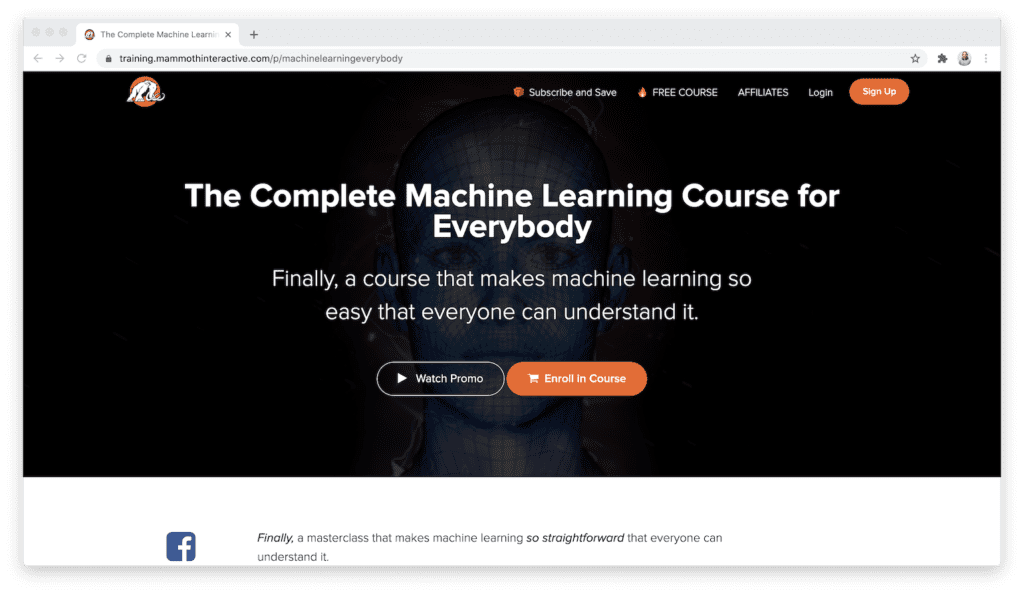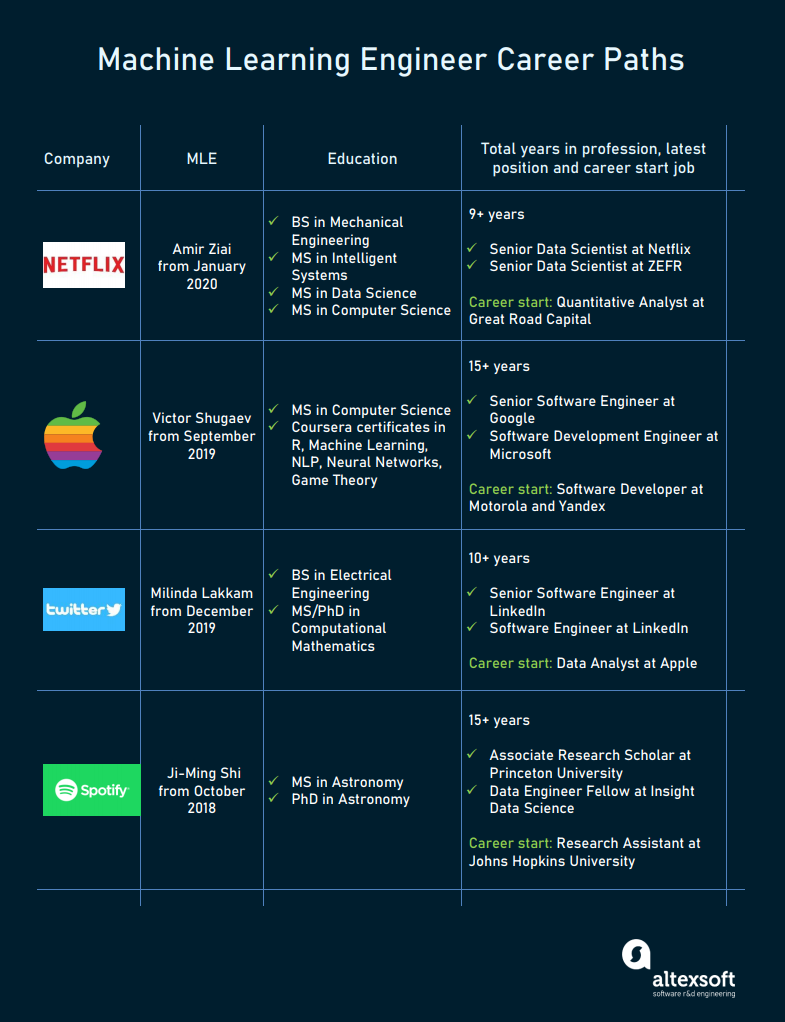All Categories
Featured
Table of Contents
- – Not known Facts About Machine Learning/ai Engi...
- – Examine This Report on Machine Learning Engine...
- – Top 20 Machine Learning Bootcamps [+ Selectio...
- – Some Ideas on Machine Learning Crash Course F...
- – The Facts About Machine Learning In Producti...
- – The 6-Minute Rule for Top 20 Machine Learnin...
You possibly know Santiago from his Twitter. On Twitter, every day, he shares a lot of sensible points concerning device discovering. Alexey: Before we go right into our major subject of relocating from software program engineering to device learning, possibly we can start with your history.
I went to college, got a computer system scientific research level, and I started constructing software program. Back then, I had no idea concerning device understanding.
I recognize you've been utilizing the term "transitioning from software program engineering to artificial intelligence". I such as the term "contributing to my ability the artificial intelligence abilities" much more due to the fact that I think if you're a software application engineer, you are currently giving a great deal of value. By incorporating device understanding now, you're increasing the influence that you can have on the industry.
Alexey: This comes back to one of your tweets or possibly it was from your training course when you compare 2 methods to learning. In this case, it was some problem from Kaggle concerning this Titanic dataset, and you simply discover exactly how to fix this problem using a specific tool, like choice trees from SciKit Learn.
Not known Facts About Machine Learning/ai Engineer
You first discover math, or linear algebra, calculus. After that when you recognize the mathematics, you go to machine learning concept and you learn the theory. 4 years later, you ultimately come to applications, "Okay, exactly how do I utilize all these four years of mathematics to resolve this Titanic trouble?" ? In the former, you kind of save on your own some time, I believe.
If I have an electrical outlet below that I need replacing, I don't want to go to college, invest four years comprehending the math behind electrical energy and the physics and all of that, simply to change an electrical outlet. I would certainly rather start with the outlet and locate a YouTube video clip that aids me go with the trouble.
Bad analogy. You get the concept? (27:22) Santiago: I really like the concept of beginning with an issue, trying to toss out what I understand approximately that problem and understand why it doesn't work. Grab the devices that I need to resolve that issue and start digging deeper and deeper and deeper from that point on.
Alexey: Possibly we can chat a bit regarding learning sources. You mentioned in Kaggle there is an intro tutorial, where you can obtain and find out just how to make decision trees.
The only need for that training course is that you know a little bit of Python. If you're a designer, that's a terrific base. (38:48) Santiago: If you're not a developer, then I do have a pin on my Twitter account. If you go to my profile, the tweet that's mosting likely to get on the top, the one that states "pinned tweet".
Examine This Report on Machine Learning Engineer Vs Software Engineer

Also if you're not a programmer, you can begin with Python and work your means to even more maker discovering. This roadmap is focused on Coursera, which is a platform that I truly, really like. You can investigate every one of the courses totally free or you can pay for the Coursera membership to obtain certifications if you desire to.
Alexey: This comes back to one of your tweets or possibly it was from your program when you contrast two methods to discovering. In this case, it was some problem from Kaggle about this Titanic dataset, and you simply discover how to solve this problem utilizing a particular tool, like decision trees from SciKit Learn.

You first learn mathematics, or direct algebra, calculus. When you recognize the math, you go to device discovering concept and you find out the concept.
If I have an electric outlet right here that I need replacing, I do not intend to go to university, invest 4 years recognizing the math behind electrical energy and the physics and all of that, simply to transform an electrical outlet. I would rather begin with the outlet and discover a YouTube video that aids me undergo the trouble.
Bad example. However you understand, right? (27:22) Santiago: I actually like the idea of starting with a problem, trying to throw away what I understand up to that issue and understand why it doesn't function. Order the tools that I need to solve that trouble and start excavating deeper and deeper and much deeper from that point on.
Alexey: Maybe we can speak a bit concerning finding out sources. You mentioned in Kaggle there is an intro tutorial, where you can get and find out exactly how to make decision trees.
Top 20 Machine Learning Bootcamps [+ Selection Guide] - Questions
The only requirement for that course is that you recognize a little bit of Python. If you go to my account, the tweet that's going to be on the top, the one that says "pinned tweet".
Even if you're not a programmer, you can begin with Python and function your way to more artificial intelligence. This roadmap is concentrated on Coursera, which is a system that I truly, really like. You can audit every one of the courses totally free or you can pay for the Coursera membership to get certificates if you wish to.
Some Ideas on Machine Learning Crash Course For Beginners You Need To Know
Alexey: This comes back to one of your tweets or perhaps it was from your program when you contrast two approaches to understanding. In this situation, it was some issue from Kaggle regarding this Titanic dataset, and you simply learn just how to fix this problem utilizing a certain device, like decision trees from SciKit Learn.

You first find out mathematics, or direct algebra, calculus. When you recognize the mathematics, you go to maker knowing concept and you find out the concept.
If I have an electrical outlet right here that I require changing, I do not wish to most likely to college, spend 4 years recognizing the math behind electricity and the physics and all of that, just to alter an electrical outlet. I prefer to begin with the electrical outlet and locate a YouTube video that aids me undergo the trouble.
Bad example. But you obtain the idea, right? (27:22) Santiago: I actually like the idea of starting with a trouble, trying to throw away what I understand up to that problem and understand why it does not work. Get the devices that I require to address that issue and begin excavating much deeper and deeper and much deeper from that point on.
Alexey: Perhaps we can chat a little bit regarding finding out sources. You stated in Kaggle there is an introduction tutorial, where you can get and find out exactly how to make decision trees.
The Facts About Machine Learning In Production / Ai Engineering Uncovered
The only demand for that program is that you recognize a little bit of Python. If you're a designer, that's a terrific base. (38:48) Santiago: If you're not a programmer, then I do have a pin on my Twitter account. If you go to my profile, the tweet that's going to be on the top, the one that states "pinned tweet".
Even if you're not a designer, you can start with Python and work your means to more artificial intelligence. This roadmap is concentrated on Coursera, which is a system that I actually, really like. You can examine every one of the training courses free of charge or you can pay for the Coursera subscription to obtain certificates if you intend to.
That's what I would do. Alexey: This comes back to one of your tweets or perhaps it was from your program when you compare two techniques to discovering. One technique is the issue based strategy, which you simply discussed. You discover a trouble. In this instance, it was some trouble from Kaggle regarding this Titanic dataset, and you simply discover just how to resolve this issue making use of a specific tool, like decision trees from SciKit Learn.
You first learn mathematics, or linear algebra, calculus. Then when you recognize the mathematics, you most likely to device learning theory and you learn the concept. Four years later on, you ultimately come to applications, "Okay, just how do I use all these four years of math to solve this Titanic problem?" Right? So in the former, you kind of conserve on your own some time, I assume.
The 6-Minute Rule for Top 20 Machine Learning Bootcamps [+ Selection Guide]
If I have an electric outlet here that I require replacing, I don't desire to go to college, invest four years understanding the math behind power and the physics and all of that, just to alter an outlet. I would instead begin with the electrical outlet and find a YouTube video that helps me go with the trouble.
Bad example. However you get the idea, right? (27:22) Santiago: I really like the idea of starting with a problem, attempting to throw away what I recognize approximately that issue and understand why it does not function. Then get hold of the tools that I require to solve that trouble and begin excavating much deeper and much deeper and deeper from that factor on.

Alexey: Maybe we can speak a bit about discovering sources. You mentioned in Kaggle there is an introduction tutorial, where you can get and discover exactly how to make choice trees.
The only demand for that program is that you understand a little bit of Python. If you go to my account, the tweet that's going to be on the top, the one that states "pinned tweet".
Even if you're not a designer, you can begin with Python and function your method to even more device learning. This roadmap is focused on Coursera, which is a platform that I truly, actually like. You can investigate all of the courses absolutely free or you can pay for the Coursera subscription to obtain certifications if you wish to.
Table of Contents
- – Not known Facts About Machine Learning/ai Engi...
- – Examine This Report on Machine Learning Engine...
- – Top 20 Machine Learning Bootcamps [+ Selectio...
- – Some Ideas on Machine Learning Crash Course F...
- – The Facts About Machine Learning In Producti...
- – The 6-Minute Rule for Top 20 Machine Learnin...
Latest Posts
Senior Software Engineer Interview Study Plan – A Complete Guide
Tips For Acing A Technical Software Engineering Interview
How To Master Whiteboard Coding Interviews
More
Latest Posts
Senior Software Engineer Interview Study Plan – A Complete Guide
Tips For Acing A Technical Software Engineering Interview
How To Master Whiteboard Coding Interviews